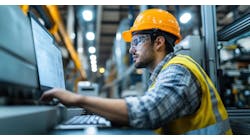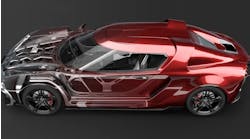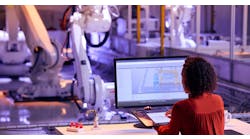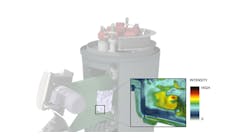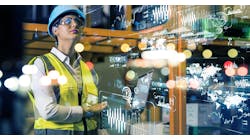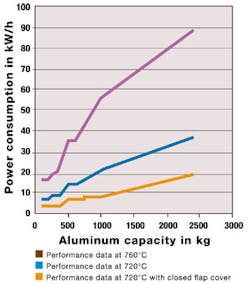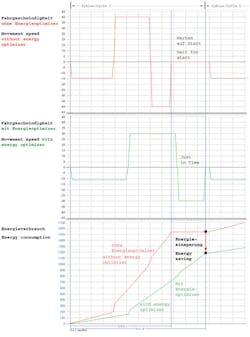Latest from Simulation/IT
It may be difficult to recognize new energy-saving opportunities in metalcasting operations. Some of these are not obvious at first glance. For example, in a diecasting sequence, a fixed amount of energy is required to inject molten metal into the die under high pressure. How can you save anything there? Reis Robotics reported that it studied the matter for several years, with some surprising discoveries. To start, in many automated diecasting operations more than 40% of energy consumption takes place while the production cell is in standby mode, meaning the robot tending the machinery is one of the less-demanding energy requirements.
Reis develops integrated automation systems centered on robotics for various industrial segments, including metalcasting. In addition to articulated-arm robots, its products include linear robots, gantries, horizontally articulated-arm robots, and other specialty robots.
The developer explained that its research of automated diecasting systems uncovered that the individual production cells, often inadvertently, are not switched off between the production cycles. As a result, they continue to consume electric power.
In an analysis of a conventional, 800-metric ton standard diecasting cell, the trim press alone consumed about five times as much current in standby mode as all other peripheral units. According to Reis, this would drive annual energy costs into the five-figure range, without any production to offset the cost. Considering that the effective production time represents 60% of the total duty cycle, the potential for savings is evident.
“We, too, were surprised how much energy is unnecessarily consumed in some systems,” explained Dr. Michael Wenzel, general manager of Reis Group Holding. “And, this is just where the competence of Reis becomes effective, because the final question is how to optimize the energy consumption for an entire process or system. But, this step also is only efficient and economic if optimization itself does not cause new high costs.”
Developing a Flexible Set-Up
Pierburg GmbH is an automotive parts manufacturer in Nettetal, Germany, that has operated various diecasting processes for many years, with almost no changes in its production practices. As energy costs rose, and with plans to relocate the operation in the near future, a decision was made to optimize diecasting cycle times and energy consumption.
All the Pierburg operations were examined closely. For example, on the basis of several decades of experience an idea was developed to divide punching and trimming into two steps so that after the rough cut a final cut would run defect-free. It turned out that air-cooling of the castings also improved by this effort because none of the blast agent would stick to the angular, still damp contours of the diecastings.
The goal was to develop a flexible standard cell for multiple products, saving energy wherever it is not needed — at least temporarily. In the project with Reis Robotics a sample cell was created that started up in mid-2012 and has shown considerable improvement in energy efficiency. Detailed energy consumption analyses were made before starting up the cell and the resulting findings were used to energy saving.
A prerequisite for optimal energy savings was a superimposed control level capable of mapping the widest variety of products, and varying the cycles for all connected system components and peripheral units accordingly. Based on input from Pierburg in the course of the project the idea emerged to develop a so-called head control, with freely programmable production sequences. Depending on the product, parts of the system that are not operating can enter into a sleep mode.
For instance, switching off those drives that are not in use saves a lot of energy. The suction hood over the casting machine, the press drives, the robots, and the cooling fans are switched off at the push of a button on the central operating unit, or automatically by the central controller. In addition, there are “weekend” and “pause” buttons for centralized on/off control of all media, drives, and lights that are likely to have been overlooked. Due to this improvement in automation technology, Pierburg is realizing energy savings up to 30%.
Energy-Saving Updates
First, energy is used for the melting process and casting itself. Then, further energy is required to cool the parts before further processing. Reis Robotics established that considerable savings potential can be leveraged by an intelligent control. In quench tanks Reis frequently applies thermostatic cooling water controls and automatic switch-off of the cooling water circulation in order not to waste this energy unnecessarily. Furthermore, a certain casting residual heat is absolutely desirable for fast drying of the parts.
For cooling of castings with air, Reis Robotics recommends using speed-controlled fans and an automatic switch-off at all the deposit spaces on the cooling rack where there is no casting.
On the cooling rack at Pierburg there is space for 10 castings. Sensors in the rack recognize when a part is placed there, and only then does it switch on the relevant fan for a defined time. Temperature sensors also are possible and have already been considered in the control.
At Pierburg the robot picks the parts from the rack after cooling and moves them into place on one of two trim presses for the next step in the production process. Activated by the head control, the trim press drives stand still until the process step is required. A conveyor system transports the scraps from the trim press into a bucket, eventually to be returned for remelting. This stage of the system also is switched off centrally as long as no transport is needed.
In an automated diecasting cell, robots consume comparatively little energy, but Reis Robotics nevertheless found some optimization opportunities. Generally, the ROBOTstarV controller is in a position to switch off the robot’s drives if they are not in use. As soon as the control receives a signal from the connected peripheral equipment to initiate a work step, the power is supplied to the process.
But, more savings are possible using energy-efficient drive motors and innovative servo controllers. Modified drive motors operate at reduced heat levels, which also lowers the expense for the cooling control cabinet. Modified servo-converters of the drive components use the brake energy of a robot axis by buffering it in an intermediate circuit for subsequent acceleration of another axis.
Furthermore, the ROBOTstar controller is able to accelerate drives only as fast as required, not as possible, to meet the required process speeds. Reis graphed the overall effect of the process optimizations in terms of energy savings.
The trim presses supplied by Reis have a so-called “load sensing” function” that allows faster production if the full performance is not required, and saves energy. Pumps no longer feed against overpressure valves at full capacity, and thus generate less heat loss.
Reis also considered the motors of these pumps in its evaluation. New, more energy-efficient motors were installed in the presses to achieve ROI more quickly. The break-even point for a 15-kW electric motor has been achieved already, and has a service life of approximately one thousand hours. A 22-kW motor reaches this point after only 600 hours of operation.
The central control of Reis Robotics can optimize the compressed-air supply too, because such systems are very energy-intensive, thus an expensive choice for the work cell design. Any savings there will have an immediate measurable effect on operating costs.
Also, according to its observations Reis Robotics concluded that for some crucible furnaces the temperature can be reduced slightly without impairing the safety or quality of the casting process. An example showed that more than 50% of energy can be saved in aluminum casting if the temperature is lowered by only 40°C. Even more energy can be saved if a crucible is covered during times when no metal is being drawn out, which is a relatively inexpensive retrofit for most crucibles.
Pierburg has been convinced of the savings possibilities and of the production flexibility of its new ‘head controlled’ diecasting cell, and plans to expand the flexible control operations at its new plant. Plans call for installing two or three of these work cells at the original plant site before the planned relocation.
The Pierburg managers see advantages in that the controls already in place make it possible to troubleshoot problems in the program, directly or via remote access. Thus, the control systems that will be installed at the new plant not only will be considerably more economical, but will be fully tested once the new plant starts in 2014.


